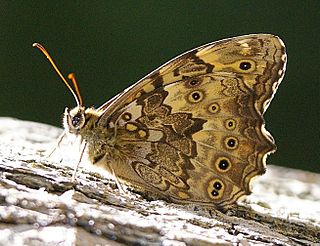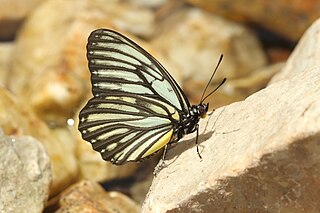
The Gandaki River, also known as the Narayani and Gandak, is one of the major rivers in Nepal and a left-bank tributary of the Ganges in India. Its total catchment area is 46,300 km2 (17,900 sq mi), most of it in Nepal. In the Nepal Himalayas, the Gandaki is notable for its deep canyon. The basin also contains three mountains over 8,000 m (26,000 ft), namely Dhaulagiri, Manaslu and Annapurna Massif. Dhaulagiri is the highest point of the Gandaki basin.

The Nepal house martin is a non-migratory passerine of the swallow family Hirundinidae. Its two subspecies breed in the Himalayas from northwestern India through Nepal to Myanmar, northern Vietnam, and just into China. It occurs in river valleys and rugged wooded mountain ridges at heights between 1,000–4,000 m (3,300–13,100 ft) altitude, where it nests in colonies beneath overhangs on vertical cliffs, laying three or four white eggs in an enclosed mud nest.
Capissa is a monotypic tiger moth genus in the family Erebidae. It was previously treated as a synonym of Eilema. Its only species, Capissa vagesa, is found in the north-western Himalayas, Kashmir, Nepal and Upper Myanmar. Both the genus and species were first described by Frederic Moore; the genus in 1878 and the species in 1860.

Cigaritis is a genus of butterflies in the family Lycaenidae. Its species are found in the Afrotropical realm, the Indomalayan realm and adjacent regions of Asia.
Barah Nagarpalika previously Mahendranagar is a municipality in Sunsari District in the Kosi Zone of south-eastern Nepal. It is situated near the Koshi River. Most of the residents, as is common in Nepal, depend on agriculture but in the last few years the trend of going to the Persian Gulf region as workers is increasing. The town is yet to have any prominent business houses but is a growing market with a number of small industries, hotels and shops. Being linked with some major cities, Dharan & Itahari of the Sunsari District, this town holds a very good chance of development. There is one community radio station also, named Sunsari FM.

Neope goschkevitschii is a Nymphalidae butterfly found in East Asia. This species looks quite similar to Neope niphonica and these two species were treated as one for a long time.

Evecliptopera is a monotypic moth genus in the family Geometridae described by Inoue in 1982. Its only species, Evecliptopera decurrens, first described by Frederic Moore in 1888, is found in northern India, Nepal, south-western China, Japan, the Russian Far East and Taiwan.
Neope pulahina, the scarce labyrinth, is a nymphalid butterfly found in India and South Asia.

Neope bhadra is a nymphalid butterfly known from Asia, where it is found from Sikkim to Upper Burma.

Neope yama, the dusky labyrinth, is a species of satyrine butterfly found in Asia. In the Himalayas it is common from the eastern Himalayas to eastern Nepal and less common from western Nepal to Himachal Pradesh.

Neope armandii is a species of satyrine butterfly found in Asia.

Neope niphonica is a member of the Nymphalidae butterfly family found in East Asia.

Neope is a genus of butterflies of the family Nymphalidae found in Asia.

Neope muirheadii, the black-spotted labyrinth, is a species of butterfly in the family Nymphalidae. It is found in western and central China, Southeast Asia, and Taiwan.
Pulaha is a character in Hindu mythology. He is the son of Brahma, the creator god, and also one of the Saptarshi, in the first Manvantara, with others being Marichi, Atri, Angiras, Kratu, Pulastya, and Vasishtha. In another classification, Pulaha is one of the ten Prajapatis, the progenitors of creation created by Brahma. The race of the kimpurushas are the children of Pulaha, according to the Mahabharata.

Hestina nicevillei, the scarce siren, is a species of siren butterfly (Apaturinae) found in the western Himalayas, Himachal Pradesh, Nepal and to China and Vietnam.











